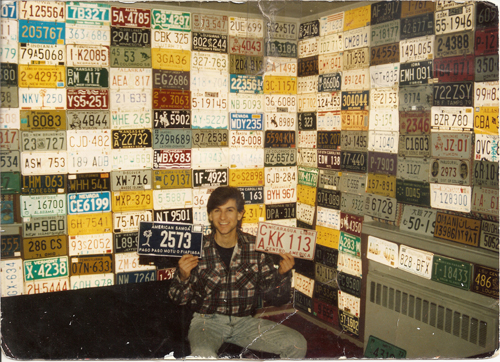Andy Bernstein in his childhood bedroom. (Photo courtesy of Andy Bernstein)
Not every family road trip inspires a lifelong obsession. But when then-four year old Andy Bernstein’s family took a road trip from Long Island to Florida in the 1970s, the colorful out-of-state license plates zipping by on the highway were too mesmerizing to bear. Five years later, he decided he had to have one license plate from every state. He began hanging them in the bedroom he shared with his brother.
Now, the 41-year old marketing consultant has over 65,000 plates from almost every continent. He says he’s been described as a walking Wikipedia of license plates and he has long surpassed his childhood goal. His license plate knowledge is so vast that the FBI, CIA and local police agencies have sought his advice when trying to narrow down a plate based on a rough description or number configuration. He says filmmakers and prop masters call him at all hours when they’re trying to track down period plates (every plate in Silence Lambs is from his collection). And collectors from all over the world call his house day and night hoping to trade or score a set of rare plates. Bernstein sleeps with the ringer off.
Bernstein is an active member of the Automobile License Plate Collectors Association (ALPCA), which issues awards each year for the best plate (Oklahoma won for 2009). And when WNYC reported on New York’s new, retro plates (“empire gold” plates), that have began turning up on the streets of New York this spring, we wanted to check with a collector to see how New York’s new plates measure up.
“I feel they’ve digressed in their design and they could’ve done a much better job,” Bernstein says.
He says many states allow residents to vote online, but New York doesn’t.
For someone who learned geography and cultural factoids about states and countries from license plates, the complete lack of design elements on the new New York plates left Bernstein quite disappointed. He says the Statue of Liberty plates (released from 1986-2001), which commemorated the centennial, left many upstate residents miffed. He says the last round of plates, the blue and white “empire plates” (2001-2010) did a better job of recognizing the diversity of New York’s landmarks. He says the retro color and lack of graphic elements are neither very fresh nor in keeping with the nation-wide trend of working in more landmarks to plate designs.
Bernstein continues to pursue rare and interesting plates from around the world. So, what is a rare plate?
The New York “Pearl Harbor Survivor plate,” Bernstein says. “For somebody to have been in Pearl Harbor when they were bombed and you still have to be driving, those plates, you’re not going to see so many. There are some categories out there that will really blow your mind.”
The DMV Web site does present a staggering array of choices from sports plates with the American Bowling Congress logo to plates that go toward supporting the Erie Canal Museum.
“It’s a little overwhelming; you can’t keep up with it. It’s impossible to keep up with. I’ve heard cases every week where someone’s talking with someone at the DMV and the DMV has no idea what license plate that person is even talking about because the DMV has never heard of it,” Bernstein says.
Bernstein stores his collection at his home and the homes of his parents and his girlfriend. He travels with a crumpled photo of himself in his bedroom surrounded by colorful plates because he’s been questioned too many time by suspicious customs agents (see photo at the top) in various countries.
He says he obtains all his plates legally. When he started, Bernstein tried to complete an entire “run” of plates—for example, with New York starting in 1910 when the state started issuing plates, up to the present. He’d leave notes on people’s cars asking for their old plates and would chase down people moving to different states to see if they’d donate their plates to his collection.
Now he travels to salvage yards around the world and relies on phone calls from his contacts. Recently he got a call about a rare porcelain plate found in a pot belly stove at an antique shop.
“Its crazy. It’s a crazy hobby, but it’s a great hobby. I’ve met people from every walk of life and you learn so much by collecting these things,” he says.

